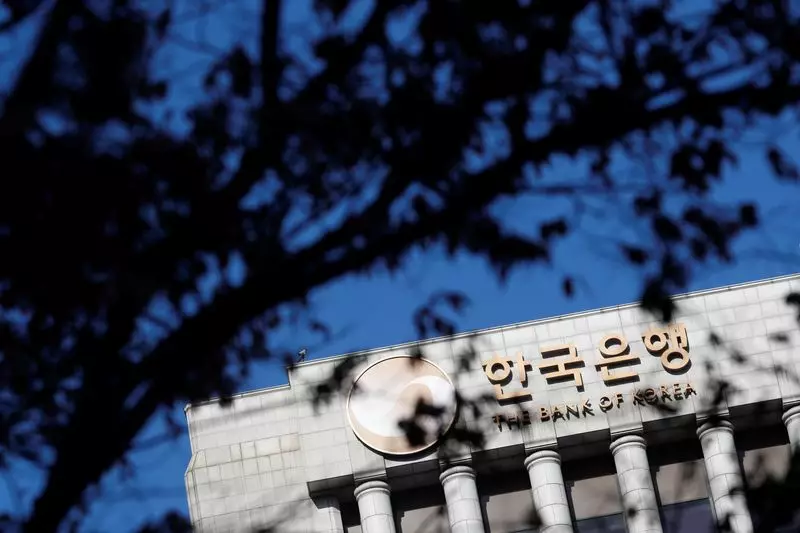In a significant move that caught many analysts off guard, the Bank of Korea (BOK) announced an unexpected reduction in interest rates, marking the second consecutive cut aimed at revitalizing an economy showing signs of faltering growth. The central bank lowered the benchmark interest rate to 3.00%, a decision that only a minority of economists had anticipated prior to the announcement. This proactive stance by the BOK underscores the increasing urgency to address the mounting economic challenges faced by South Korea, particularly in the context of a shifting global trade environment.
The BOK’s decision was not unanimous; a five-to-two vote among the seven-member board highlighted a divergence of opinions regarding the need for immediate policy changes. Governor Rhee Chang-yong’s commentary after the decision indicated an openness among some members to additional rate cuts within the coming three months. The backdrop of this monetary policy shift includes increasing global economic uncertainties, particularly those associated with a potential second presidency for Donald Trump. The ramifications of a Trump administration on trade policies and competition in the global marketplace could impose significant strains on South Korea’s economy, which heavily relies on exports.
The Impact of Global Trade Dynamics
The implications of Donald Trump’s re-election could potentially heighten competition in exports, compelling the South Korean government to strategize accordingly. In a recent statement, Governor Rhee expressed concerns about intensified export competition and the unpredictable nature of international trade resulting from Trump’s electoral victory. His sentiments reflect a broader recognition of the risks posed by foreign policy changes and tariffs, particularly towards major trading partners such as China, which could face tariff hikes of up to 60%.
This altered trade landscape plays a critical role in South Korea’s economic forecasting. In 2023, South Korea recorded an unprecedented trade surplus of $44.4 billion with the United States, a stark contrast to its trade relations with other global partners. The pressures from the evolving international trade dynamics underscore the need for the South Korean government to safeguard core economic sectors, particularly the homegrown chip industry, which is vital for technological innovation and economic growth.
The government has already signaled its intention to enhance support for local semiconductor manufacturers, who may face potential setbacks from new U.S. trade policies. This focus on technological industries will be crucial as policymakers look to reinforce their economy amid these turbulent trade conditions.
Economic growth in South Korea has shown signs of sluggishness, with the nation barely avoiding a technical recession in the third quarter of this year. The economy recorded a meager expansion of just 0.1%, following an earlier contraction, highlighting a worrying trend that has policymakers on high alert. As private consumption waned and exports stagnated, the government’s inclination to draft a supplementary budget reflects the heightened need for interventions to promote economic stability.
The BOK’s downward revision of growth forecasts, projecting a 2.2% growth rate for 2024 compared to an earlier 2.4% estimate, signifies broader economic concerns. Furthermore, the central bank expects consumer inflation to slow down to 2.3% for the year, deviating from its earlier forecast of 2.5%. Such adjustments indicate an economic landscape that necessitates cautious policymaking and a proactive approach to stimulate growth.
In the wake of the BOK’s interest rate cut, South Korea’s three-year treasury bond futures experienced a rise in value, a clear indication of market participants’ response to the central bank’s shift in monetary policy. However, the South Korean won, already struggling as one of the worst-performing currencies in Asia this year, continued to weaken, raising concerns about currency stability in light of the BOK’s commitment to work in tandem with the government to reinforce the forex market.
As other countries, including New Zealand, Canada, and Sweden, have also implemented substantial rate cuts in recent months, the collaborative approach among nations emphasizes the interconnected nature of global economic challenges. The BOK’s anticipated further cuts could serve as a necessary mechanism to navigate the difficult economic waters ahead, reinforcing growth and mitigating potential trade-related fallout in an increasingly speculative environment.
As South Korea contends with both domestic economic pressures and international trade uncertainties, its central bank’s commitment to strategic monetary policy adjustments will be crucial. The steps taken today could be pivotal in shaping the nation’s economic trajectory in an unpredictable global landscape.

